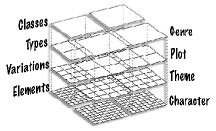Traditional Genres
The Elements Of Structure: Genre
Building Genres
Previously, we have seen that the characteristics, which build the Overall Story Characters, reside at the Element level of the Thematic Structure. Theme itself emanates most strongly from the Variation level. Plot is formed in the Types. It should not be a surprise to find that Genre is most influenced at the Class level. In fact, matching a point of view to a Class creates a story's Throughlines, and it is these Throughlines that have the greatest structural impact on Genre.

As one moves up the Dramatica structure, looking from Character to Theme to Plot, the structural components (the Elements, Variations, and Types) take on a decreasing significance to the finished work compared with the storytelling aspects involved. Overall Story Characters are easy to define solely in terms of their Elemental dramatic functions. Theme is a bit less tied to the structure as it explores the comparison between dramatic Variations whose balance must be established by the author through storytelling. Plot can be looked at rather precisely in terms of Acts, but is less so when it comes to thematic Sequences. At the Scene resolution of Plot a large part of what goes on is storytelling. At Event resolution, deciding exactly what events ought to occur is almost exclusively storytelling, with the events falling into four broad structural categories.
Following this progression, Genre, which centers on the Class level just above where we find Plot, is the least structural of story qualities. Genre is also the most influenced by storytelling.
In a casual sampling of traditional Genres, we immediately notice that Genre sometimes refers to the setting of a story, as in Westerns or Science Fiction. Other times, it describes the relationships between characters such as Love Stories and Buddy Pictures. Genre might refer to the feeling an audience gets from a story as in Comedy and Horror Stories. Even styles of storytelling can have their own genres like Musicals or Character Studies.
With all these different duties performed by the word Genre, how can we hope to define it? Video rental stores try to do it. All the old standards are there dividing the movies on their shelves: Action, Drama, Children's. This is fine for picking out what you want to watch some evening, but not much help to authors trying to create stories of their own.
Producer: Write me a war story!
Writer: O.K. What do you want, something like M.A.S.H. or Platoon or The Great Escape?
Traditional genre categories are only useful for grouping finished works. The overall feel of a story is created from a blending of many different components that have an impact on the audience. These range from the underlying dramatic structure (storyform) through the subject matter (encoding) and style (weaving) to audience expectations (reception).
The traditional concept of Genre is most useful to writers by keeping them mindful of the flavor" of their story, no matter if they are working on character, plot, or theme. Genre would be a lot more useful if it was clearly definable. This is where Dramatica can help.
Dramatica intends to help writers build the deep structure that underlies their stories. This framework functions as the dramatic skeleton on which we build the specifics of a story. Story encoding then places muscle on the skeleton, Story weaving clothes the creation, and Reception affects how the audience might react to such a thing.
When considering Genre from an author's point of view--rather than the traditional audience point of view--the most critical facet will be structural. That is where we lay the foundation on which we build the storytelling. The first step of seeing Genre this way is to look at the four Classes. These four Classes suggest the nature of the subject matter covered in a story's Genre. To recap, the four Classes are:
•Situation--an external state; commonly seen as a unchanging situation.
•Activity--an external process; commonly seen as an ongoing activity.
•Fixed Attitude--an internal state, commonly seen as a fixation, prejudice or bias.
•Manipulation--an internal process; commonly seen as a manner of thinking or psychology.
